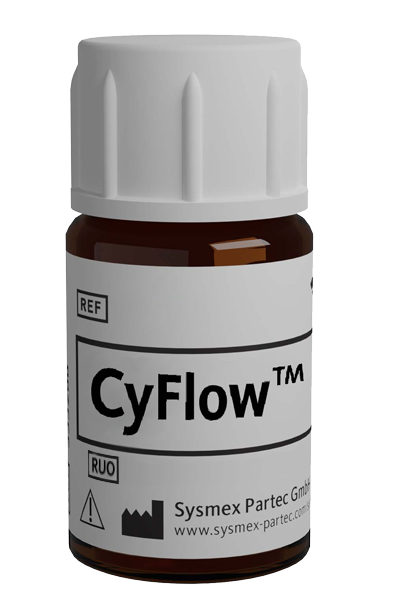CyFlow™ CD86 FITC

| Alternative Name: | B7-2, B70 |
| Antibody: | Yes |
| Antigen: | CD86 |
| Application: | Flow cytometry |
| Clonality: | monoclonal |
| Clone: | GL-1 |
| Emission Maximum: | 518 nm |
| Excitation Maximum: | 490 to 495 nm |
| Field of Interest: | Immunophenotyping, MHC |
| Format/Fluorochrome: | FITC |
| Isotype: | IgG2a |
| Laser: | Blue |
| Regulatory Status: | RUO |
| Source Species: | Rat |
| Target Species: | Mouse |
| Product number: | CQ603647 |
For Research Use Only
| Concentration Unit | mg/mL |
| Concentration | 0,5 |
| Quantity | 0.1 mg |
| Volume | 0.2 mL |
| Immunogen | LPS-activated CBA/Cs mouse splenic B cells |
| Background Information | CD86 (B7-2) and CD80 (B7-1) are ligands of T cell critical costimulatory molecule CD28 and of an inhibitory receptor CD152 (CTLA-4). Both B7 molecules are expressed on professional antigen-presenting cells and are essential for T cell activation, both molecules can also substitute for each other in this process. The question what are the differences in CD80 and CD86 competency has not been fully elucidated yet; there are still conflicts in results about their respective roles in initiation or sustaining of the T cell immune response. |
| Usage | The reagent is designed for Flow Cytometry analysis. Suggested working usage is 2·µg/ml. Indicated dilution is recommended starting point for use of this product, but working concentrations should be validated by the investigator. |
| Storage Buffer | The reagent is provided in phosphate buffered saline (PBS) solution, pH ≈7.4, containing 0.09% (w/v) sodium azide. |
| Storage | Avoid prolonged exposure to light. Store in the dark at 2-8°C. Do not freeze. |
| Stability | Do not use after expiration date stamped on vial label. |
| Hathcock KS, Laszlo G, Dickler HB, Bradshaw J, Linsley P, Hodes RJ: Identification of an alternative CTLA‑4 ligand costimulatory for T cell activation. Science. 1993 Nov 5; 262(5135):905‑7. < PMID: 7694361 > | Benschop RJ, Melamed D, Nemazee D, Cambier JC: Distinct signal thresholds for the unique antigen receptor‑linked gene expression programs in mature and immature B cells. J Exp Med. 1999 Sep 20; 190(6):749‑56. < PMID: 10499913 > | Brasel K, De Smedt T, Smith JL, Maliszewski CR: Generation of murine dendritic cells from flt3‑ligand‑supplemented bone marrow cultures. Blood. 2000 Nov 1; 96(9):3029‑39. < PMID: 11049981 > | Chung JB, Wells AD, Adler S, Jacob A, Turka LA, Monroe JG: Incomplete activation of CD4 T cells by antigen‑presenting transitional immature B cells: implications for peripheral B and T cell responsiveness: implications for peripheral B and T cell responsiveness. J Immunol. 2003 Aug 15; 171(4):1758‑67. < PMID: 12902475 > | Steptoe RJ, Ritchie JM, Jones LK, Harrison LC: Autoimmune diabetes is suppressed by transfer of proinsulin‑encoding Gr‑1+ myeloid progenitor cells that differentiate in vivo into resting dendritic cells. Diabetes. 2005 Feb; 54(2):434‑42. < PMID: 15677501 > | Nolan A, Weiden M, Kelly A, Hoshino Y, Hoshino S, Mehta N, Gold JA: CD40 and CD80/86 act synergistically to regulate inflammation and mortality in polymicrobial sepsis. Am J Respir Crit Care Med. 2008 Feb 1; 177(3):301‑8. < PMID: 17989345 > | Edgtton KL, Kausman JY, Li M, O'Sullivan K, Lo C, Hutchinson P, Yagita H, Holdsworth SR, Kitching AR: Intrarenal antigens activate CD4+ cells via co‑stimulatory signals from dendritic cells. J Am Soc Nephrol. 2008 Mar; 19(3):515‑26. < PMID: 18184859 > | Radhakrishnan S, Arneson LN, Upshaw JL, Howe CL, Felts SJ, Colonna M, Leibson PJ, Rodriguez M, Pease LR: TREM‑2 mediated signaling induces antigen uptake and retention in mature myeloid dendritic cells. J Immunol. 2008 Dec 1; 181(11):7863‑72. < PMID: 19017976 > | Nolan A, Kobayashi H, Naveed B, Kelly A, Hoshino Y, Hoshino S, Karulf MR, Rom WN, Weiden MD, Gold JA: Differential role for CD80 and CD86 in the regulation of the innate immune response in murine polymicrobial sepsis. PLoS One. 2009 Aug 12; 4(8):e6600. < PMID: 19672303 >
